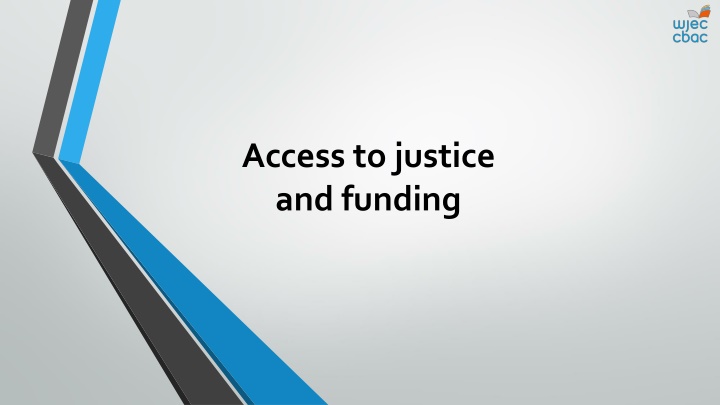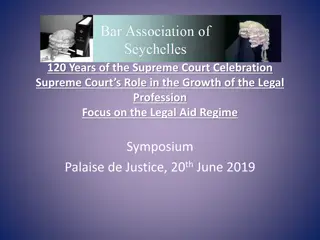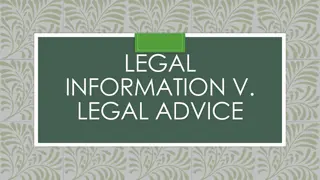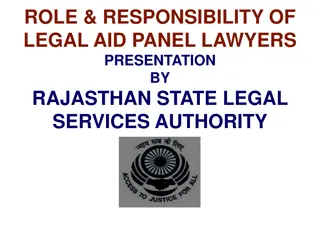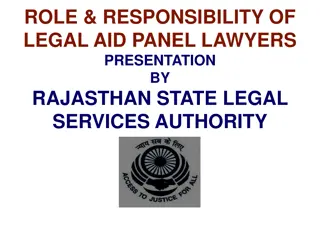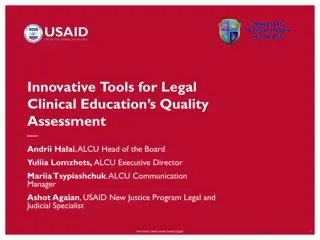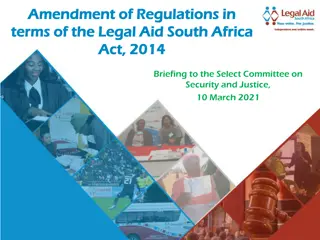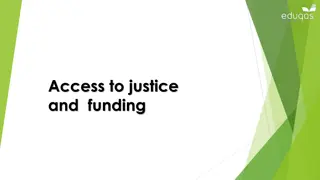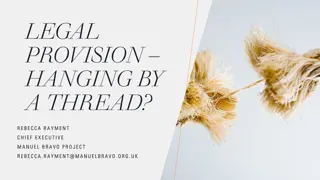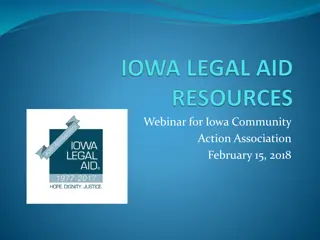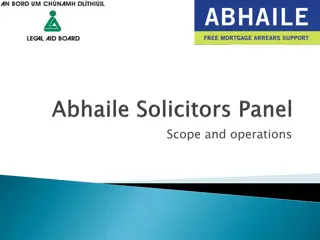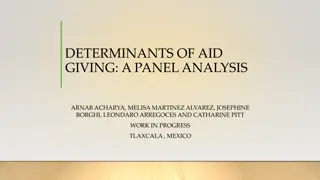Evolution of Legal Aid: From Inception to Present Challenges
The evolution of legal aid from its establishment in 1949 to the current challenges faced post the Legal Aid, Sentencing and Punishment of Offenders Act 2012 has been marked by changes in funding, administration, and accessibility. Despite initial state-funded schemes and subsequent reforms, recent years have seen a reduction in civil and criminal legal aid availability, impacting individuals' access to justice. The shift from the Legal Aid Board to the Legal Services Commission and the introduction of new schemes reflect the ongoing struggle to balance legal aid provisions with cost constraints and changing legal landscapes.
Download Presentation

Please find below an Image/Link to download the presentation.
The content on the website is provided AS IS for your information and personal use only. It may not be sold, licensed, or shared on other websites without obtaining consent from the author.If you encounter any issues during the download, it is possible that the publisher has removed the file from their server.
You are allowed to download the files provided on this website for personal or commercial use, subject to the condition that they are used lawfully. All files are the property of their respective owners.
The content on the website is provided AS IS for your information and personal use only. It may not be sold, licensed, or shared on other websites without obtaining consent from the author.
E N D
Presentation Transcript
Access to justice and funding
Discussion Questions Q. What is legal aid ? A.State- funded legal help Q. What is meant by the unmet need for legal services? A.A person has a problem which could possibly be solved by going to law, but that person is not able to get the help he/she needs from the system.
Discussion Questions Q. For what reasons do you think someone would fail to get the legal help they need? A person: fails to see that their problem has legal implications chooses not to pursue the case because of implications like cost, sees solicitors as unapproachable does not know of the existence of a legal service or cannot find one who could help.
History of Legal Aid 1949 1st state-funded legal aid scheme 1980s system had developed into 6 different schemes Legal Aid Board administered the schemes Cost of the system escalating 1999 Access to Justice Act 1999 major changes to the system 2012 Legal Aid, Sentencing and Punishment of Offenders Act 2012 introduced further cuts to legal aid.
Access to Justice Act 1999 Key changes brought in by the 1999 Act Legal Aid Board replaced with Legal Services Commission Community Legal Services Partnerships developed Introduction of a quality mark 6 schemes replaced with 2 new schemes: - Community Legal Service - Criminal Defence Service
Legal Aid today The Legal Aid, Sentencing and Punishment of Offenders Act 2012 (LASPO) has dramatically reduced the availability of civil legal aid, criminal legal aid is also being reduced Legal aid is now administered by the Legal Aid Agency who is in turn controlled by the Ministry of Justice
Civil legal aid LASPO civil legal is only available where the subject area is listed in Schedule 1 This concerns cases primarily that are directly concerned with an individual's human rights Civil legal aid is no longer available for: Medical negligence Welfare benefits Employment, consumer disputes Education (except special needs cases) Immigration Housing cases Private family cases do not qualify for legal aid unless the case involves domestic violence, child abduction or a forced marriage.
Civil legal aid Civil legal aid has been retained for: Environmental law; Asylum; Clinical negligence cases (where the negligence occurred during the first few weeks of life); Mental health and child welfare cases; and Judicial review Means tests for civil legal aid have been tightened
Civil legal aid Civil Legal Advice (CLA) is a national telephone service and website that provides free legal advice on civil matters.
Criminal legal aid Still given on a demand-led basis, no set budget, all cases that fit the merits and means test criteria will be funded The Legal Aid Agency funds directly the provision of criminal legal services, it employs public defenders and pays for duty solicitor schemes Therefore criminal legal services are provided by both public and private lawyers.
Criminal legal aid Contracts for criminal legal aid there will be 2 different contract types: A set number of Duty Provider contracts awarded in each geographic area through competitive tendering Unlimited number of Own Client Work contracts to any provider who satisfies the requirements.
Criminal legal aid Means tested The Criminal Defence Service Act 2006 reintroduced the means test for criminal cases in the magistrates court, Crown court cases had a means test reintroduced in 2010 LASPO 2012 introduced a further financial eligibility threshold in the Crown Court - this will again restrict those eligible for legal aid If the defendant is acquitted their contributions will be refunded.
Public defenders The Legal Aid Agency employs a number of criminal defence lawyers, known as public defenders They are limited in number and there are no plans to expand the scheme
Criminal Defence direct A telephone service called Criminal Defence Direct was set up in 2005 it provides free telephone advice to people detained by the police for non-imprisonable offences.
Problems with the legal aid system Access to justice is often denied Problems with the public defender scheme The cost of criminal cases Unfair trial if legal aid is refused Too heavy a reliance on private practice.
Other Legal Service Providers Other than solicitors and barristers what other agencies/ persons offer legal advice? Law centres Community Legal Advice Centres Citizens Advice Bureaux LAs Trade Unions Motoring organisations Pro Bono clinics Insurance
Conditional Fee Agreements Courts & Legal Services Act 1990 & Access to Justice Act 1999 How do they work? Solicitors can agree to take no fee, or a reduced fee if they lose, and raise their fee by an agreed percentage if they win (maximum of double usual fee) Extra fee is called the uplift or success fee Loser pays winner s costs and the uplift and if the court orders the insurance premium. This is also the case if insurance has been taken out Access to Justice Act 1999 conditional fee available for all cases except medical negligence.
Conditional Fee Agreements -Problems Coventry v Lawrence (No 2) (2014) The homeowners had won a claim for insurance against a small business operating a noisy speedway track near their home. The claim was worth 74 000, but the costs order against the business was 640 000;the Supreme Court suggested that cost arrangements for conditional fee agreements might breach a defendant s right to a fair trial. Defendants who lose their case have to pay the lawyer s success fee and following this, the event insurance of the winning party. In this instance in particular, this can be extremely costly.
Conditional Fee Agreements -Problems In Motto v Trafigura (2011) The most expensive case in legal history. Lawyers brought a claim on behalf of 30,000 Africans who had suffered ill health when a contractor illegally dumped toxic waste in the sea near where they lived. They won the case and were awarded 30 million, entitling each person to 1,000 compensation. The lawyers working under a conditional fee agreement charged a 100% success fee which amounted their bill to over 100 million; the defendants challenged this and the bill was then reduced by 40%.
Conditional Fee Agreements after LASPO 2012 Since LASPO 2012 - the success fee for conditional fee agreements is no longer recoverable from the losing party, except for privacy, defamation and insolvency claims The client will now have to pay the uplift fee themselves even if they win their case For personal injury cases the success fee is now capped at 25% For all other cases the success fee can be 100% of the lawyer s usual fee The result is that conditional fee agreements will probably be used less
Contingency fee agreements LASPO 2012 Under a contingency fee agreement lawyers receive a share of the successful claimant s award of damages Contingency fee comes from the fact that the payment of the lawyer is contingent on the claim being successful and damages being awarded Before 2012 they were generally unlawful LASPO now allows lawyers to enter into contingency fee agreements known as damages-based agreements with their clients Lawyers are allowed to revive up to 25% of the damages for personal injury cases, 35% for employment cases and 50% for all other cases If the defendant loses they pay the claimants costs, if the claimant loses each side bears their own costs.
Advantages of contingency fee agreements No cost to the state Widens access to justice Encourages lawyers to perform better as they have a financial interest in winning.
Disadvantages of contingency fee agreements Low take up rate they are not popular with lawyers No win no fee, in reality means no win, pay anyway Lawyers too heavily involved in the financial outcome Risky, uncertain cases will not be taken on.
Reforms Lord Carter's review, Legal aid: a market-based approach to reform (2006) Government paper, Legal Aid: a sustainable future(2006) Recommendations included: Procurement contracts and Price competitive tendering Price competitive tendering received a lot of opposition and in 2014 the Government decided not to introduce price competitive tendering, instead they brought in Duty Provider work, though this is awarded through competitive tendering.
